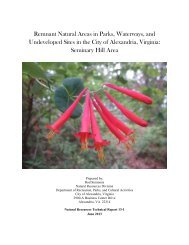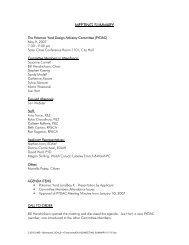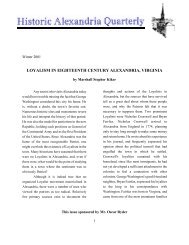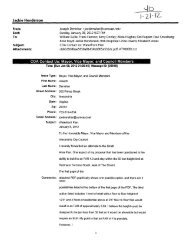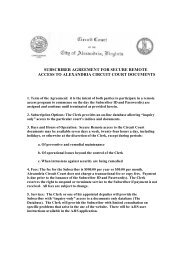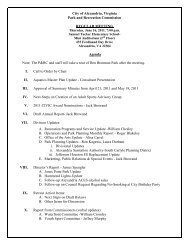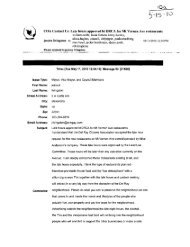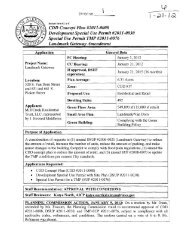Potomac Waterfront Flood Mitigation Study - City of Alexandria
Potomac Waterfront Flood Mitigation Study - City of Alexandria
Potomac Waterfront Flood Mitigation Study - City of Alexandria
You also want an ePaper? Increase the reach of your titles
YUMPU automatically turns print PDFs into web optimized ePapers that Google loves.
Technical Analyses Support<br />
resource, while indirect effects can include actions, such as changes in noise or changes to<br />
physical setting, which would diminish the historical integrity <strong>of</strong> a resource.<br />
Although the proposed flood mitigation alternatives would be undertaken by the <strong>City</strong> <strong>of</strong><br />
<strong>Alexandria</strong> or private property owners, one or more alternatives or components <strong>of</strong> these<br />
alternatives may use federal funding, such as a grant from FEMA, or may require a federal<br />
permit, such as one from the United States Army Corps <strong>of</strong> Engineers (USACE). In either case,<br />
the funding or licensing agency would be required to comply with Section 106 <strong>of</strong> the NHPA.<br />
In addition to being a locally designated historic district, the Old and Historic <strong>Alexandria</strong> District<br />
is listed in the NRHP, and as such, any undertaking affecting the district, or any contributing<br />
resource in the district, would trigger Section 106 <strong>of</strong> the NHPA. Because Section 106 applies to<br />
both NRHP-listed and NRHP-eligible properties, other potential historic properties in the project<br />
area would need to be identified by a qualified cultural resource pr<strong>of</strong>essional, and effects on<br />
these properties considered in the process. This applies to both aboveground resources such as<br />
buildings and belowground (archaeological) resources. In both cases, the funding or licensing<br />
federal agency would be responsible for conducting studies to determine what historic properties<br />
are present in the project area.<br />
For aboveground resources such as buildings, pedestrian survey and historical research would be<br />
undertaken, and a formal evaluation made as to whether or not the property meets the criteria for<br />
listing in the NRHP in consultation with VDHR and other stakeholders. For archaeological<br />
investigations in the state <strong>of</strong> Virginia, identification <strong>of</strong> historic properties is completed through a<br />
systematic investigation in the form <strong>of</strong> a Phase I Identification and, if warranted, a Phase II<br />
Evaluation.<br />
If it is determined that an undertaking will have an adverse effect on a historic property,<br />
landscape feature, or archaeological site, then federal agencies are required to consider ways to<br />
avoid or minimize those adverse effects. This may include the relocation <strong>of</strong> the project to avoid<br />
archaeological sites, or redesign to reduce the visibility <strong>of</strong> project components, incorporate<br />
buffers, or use more historically sensitive approaches. If the adverse effects cannot be avoided or<br />
minimized, then the funding or licensing agency must determine appropriate mitigation measures<br />
in consultation with stakeholders and formalize them in a legally-binding Memorandum <strong>of</strong><br />
Agreement. For aboveground historic properties, mitigation measures could include recordation<br />
<strong>of</strong> a historic property through written and photographic documentation, measured drawings,<br />
architectural salvage, or public interpretation through exhibits or Web sites. For archaeological<br />
resources, mitigation <strong>of</strong>ten takes the form <strong>of</strong> Phase III Treatment.<br />
4.3 OVERVIEW OF NATURAL RESOURCES CONTEXT<br />
Projects in <strong>Alexandria</strong> occurring in the <strong>Potomac</strong> River require authorization by USACE Norfolk<br />
District, the Virginia Department <strong>of</strong> Environmental Quality (VDEQ), Virginia Marine Resources<br />
Commission (VMRC) Habitat Management Division, and the <strong>City</strong>. Any proposed construction<br />
on the Virginia shoreline requires both VDEQ and VMRC Water Protection Permits for impacts<br />
to state-owned subaqueous bottom and/or tidal wetlands.<br />
The National Park Service (NPS) owns Jones Point Park and the George Washington Memorial<br />
Parkway. Any work that affects either property would require a temporary construction permit,<br />
28-JUL-10\\ 4-6



